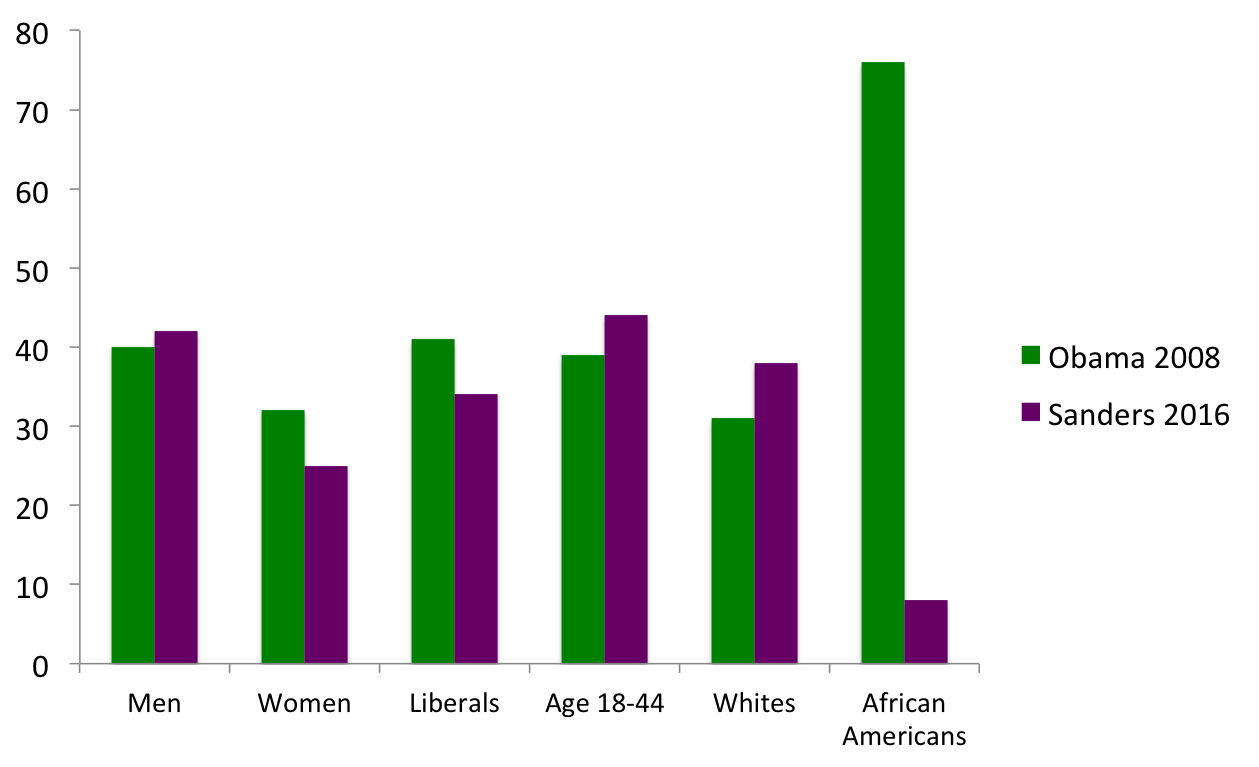Senator Bernie Sanders has staged an impressive insurgency so far against the Democratic party’s presumed choice for its presidential nominee, Hillary Clinton. In some ways, he’s following a similar path that Barack Obama forged against Clinton eight years ago, inviting numerous comparisons. But the coalition backing Sanders differs from the one that backed Obama in important ways.
To compare the two, I have looked at a recent survey by Public Policy Polling among likely Democratic primary voters across the nation. I have also examined an Economist/YouGov/Polimetrix poll conducted in late January 2008, a similar point in that cycle. There are some similarities in the races at these two times. In the recent poll, Clinton maintained a healthy overall national lead over Sanders, 53–32. At that point in 2008, Clinton led Obama 43–35, with John Edwards still pulling 16 percent. So although these are different polls from different polling organizations and different races using different methodologies, the insurgent candidates were at pretty similar levels of public support.
(It may be inappropriate to refer to Obama as an insurgent in 2008. Even though party insiders leaned toward Clinton early in that cycle, he had the backing of many prominent leaders, including Harry Reid and Ted Kennedy, and a number of prominent party insiders had simply held back and backed no one until after the Iowa Caucus. Sanders, by contrast, has gotten by with virtually no support from the party’s leadership, even post-Iowa.)
If we break down the candidates’ support by various demographic subgroups, we see some rather interesting similarities and distinctions:

Sanders’ and Obama’s levels of support are surprisingly similar across several subgroups, including men, women, whites, liberals, and younger voters. The one striking disparity is among African Americans. Barack Obama had tremendous support from the African-American community. In the 2008 survey, 76 percent of African Americans said they were supporting Obama; only 16 percent were backing Clinton. Today, however, the tables are reversed, with only eight percent of African Americans backing Sanders, and 82 percent backing Clinton.
This is obviously a substantial shift from 2008. African Americans, who comprise over one-fifth of Democratic voters, have swung dramatically toward Clinton. Her avid courtship of African-American votes and her championing of many issues of importance to black leaders has helped her to win over support in the absence of an African-American candidate. Her recent endorsement from the Congressional Black Caucus is a testament to these efforts and will only help her in this regard.
Of course, these patterns aren’t written in stone. It’s possible African Americans could shift into Sanders’ camp at some point, although it’s hard to know what set of events would bring that about. It’s also certainly possible that the party could nominate someone when one-fifth of its voters are strongly in favor of someone else. But those who see Sanders pulling a re-play of Obama’s 2008 upset should recognize that there is a substantial and pivotal group almost entirely absent from the former’s coalition.
Addendum: Looking at the Latino vote across these polls is interesting, and suggests that Sanders has substantially more Latino support than Obama did eight years ago. I spoke with a representative at Latino Decisions, however, who reminded me that different polling organizations divine Latino preferences with striking dissimilarities. Those that use robo-polls with just English language prompts will get very different results from those who utilize Spanish-language interviewers. Thus it’s difficult to find direct comparisons across both years.





